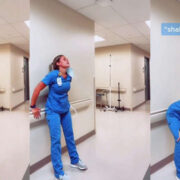How the Change Curve Brought Me Back.
As a nurse, I’ve dealt with a lot in life. I’ve seen a lot of death, I’ve seen a lot of life. What I hadn’t experienced before now, is loss. I’d gone through life pretty unscathed, and so my reaction to a lot of what I experienced at work was compassion, but with a thick skin. I was one of THOSE nurses that seemed to be a bit more harsh. While I had compassion you wouldn’t have really thought I did. I scoured at the drunk that threw themselves into the ER at 2am. I judged the woman who came in with bruises on her face blaming a fall down the stairs. I thought I was almost emotionally invincible, which I felt aided me in my work, until 2018 happened.
My father committed suicide, my grandfather died and my partner and I broke up. My World collapsed. I kept a brave face for everyone to see, occasionally letting people in to what was going on. But on the inside, I was dying. I knew I was grappling something dark, but I kept refusing to face it. I would blow up on friends and family occasionally when I reacted to something bad. Imagine a mac truck hitting you and then reversing over you. That’s what 2018 felt like for me. Spiraling is a thing, and each day I was getting worse.
Getting out of bed every day was a challenge. Especially during the darker mornings. I don’t have kids, my family lives in another state. All I had were my friends, who were amazingly supportive. At home, I would be in a bubble that I couldn’t get out of. Once I got to work, things seemed to run along. I was so busy that I didn’t have time to think. Until I started seeing people come into the Hospital with life changing illnesses, death, change. Anything remotely emotional had me running to the bathroom to explode and breakdown.
My thick skin disappeared. I had been so lucky in my 45 years to never really encounter a broken heart or death in the family but the dark cloud was getting worse. I couldn’t move on. Everything I held close to me felt like it had sunk away, and I struggled to see the other side, to see the light at the end of the tunnel, to see a future. My work was suffering too. My notes were a mess, I couldn’t think and I was getting scared that I’d make a mistake with a patient. I couldn’t take time out. What was I going to do, sit around and think all day? I had to work. I was stuck in a cycle of thinking what if? What if I did this, what if I called my dad that day? What if I treated my boyfriend better? I moved out from our home and into an apartment. I started sinking. Then came thoughts of suicide. It was a passing thought to begin with, but the feeling was getting stronger. I started Googling ways to do it. As a nurse I knew the way to do it with medication, but I wanted an easy out. I thought of just accidentally walking out in front of traffic, it would be easier and not necessarily my fault. It might also be easier on my family. The thoughts got worse and worse until one day, I was convinced it would be my last. I called a friend and he immediately had me call my doctor. The doc wanted to hospitalize me. I couldn’t. I had to convince him that I was fine and that I wouldn’t do anything. He took a risk and let me go home. Later that week I saw him again along with a therapist and started a course of Welbutrin.
The medication didn’t kick in for at least a month. I knew that nothing was going to change. No white knight in shining armor was going to come and save me just because I had a rough ride. I started looking at methods of coping. I kept blaming the whole depression on my relationship breaking down, but the picture was bigger than that. I didn’t grieve my father or grandfather, I had just been running on autopilot all year. When things got rough, I worked my ass off. Things took a worse turn when I started having an adverse reaction to the Welbutrin. Along with sleepless nights, dry mouth and ear ringing to the point where I thought I had infections, I was feeling more suicidal. I quickly learned that nothing was going to drag me out. Only me, myself and I.
This is where I studied the change curve.
As a nurse, you watch your patients deal with all kinds of change. Some people may lose a loved one, while others grapple with a life-changing diagnosis. Helping people make sense of these changes is a fundamental part of your duties as a nurse. You may be the one that has to deliver the bad news, which means the patient will look to you for support and understanding. But humans tend to deal with change in similar ways as illustrated in the Change Curve. This psychological model tells us that most people go through six distinct stages when responding to change, including denial, guilt, confusion, acceptance, problem solving and moving on.
I studied it radically but the hardest part was putting it into practice for myself. I drew it out and put it on my fridge so I would remember what to do every time I got up in the morning.
Learning this model helped me move on. Moving to stage 5 was imperative, as a human, you will constantly be drawn to stay in Stage 2. This model will help you better understand what your patients are going through, but will also apply to anything in your day to day life when you go through change. When people are dealing with change, you can help them move on and put their lives back together.
What the Change Curve Tells Us
The Change Curve shows us that people tend to respond to change in predictable ways. According to the model, here are the stages people go through when adjusting to change:
- Stage 1: Denial – Tendency to blame others, refuse to believe the change is happening or permanent.
- Stage 2: Guilt – Tendency to blame self as a way of coping with the change.
- Stage 3: Uncertainty and Confusion – Starts to accept change but not sure how to move on with their life.
- Stage 4: Acceptance – Learns to accept the change and starts exploring what it means.
- Stage 5: Problem Solving – Learns to embrace the change and begins making sense of their new life.
- Stage 6: Moving On – Fully accepts change and develops a new status quo.
While these stages give us an outline of how most people react to change, they are not set in stone. A person’s reactions will vary based on the change in question. Some people may react differently to change than others. Despite these variables, it’s important to keep these stages in mind when helping patients overcome a setback.
You may not see a patient or their family long enough to help them through all stages, so the following applies to any situation.
How to do it.
Stage 1 and 2: Based on what we’ve just learned from the Change Curve, we see that people tend to have a hard time accepting change in the moment. They may be angry, depressed, or hysterical when they first hear the news that their life has changed. According to the model, the best thing you can do during these first couple stages of grief and shock is to listen to the person and their concerns. Try not to interrupt them as they react; it’s just important to make the patient feel heard. Do not offer suggestions, explanations, or even agree with the patient, but let them know that you’re listening.
Stage 3: Once the person lets the news sink in, they will move on to confusion and acceptance. Now that they’ve realized the change is permanent, they can start to look towards the future, even if they’re not sure how to move on with their life. After learning of a loved one’s death or a diagnosis, they might start to worry about their job, kids, or finances. This is a sign that they’ve accepted the change are ready to move on with their lives. You can start giving them direction and emotional support. Help them make sense of this new reality and how they can make the best of it.
Stage 4: Slowly, the person will start accepting the change and making sense of what it means. Talk with them about their feelings and what this change means for their life going forward. Some people may start to slide back towards grief as the new reality becomes too painful. Try to help them stay positive as they continue processing the situation.
Stage 5: Finally, the person will start to think critically about how they can move on with their life. They will start solving problems as they go about putting their life back together. Again, it’s important to listen to them and provide feedback and support. Help them understand the benefits of the change to prevent them from regressing back towards grief and denial.
Stage 6: At the end, the person will start to settle into their new lifestyle. They will fully embrace the change and start looking towards the future. Help them learn from the change as they try to move on from their grief and pain.
Learning the Change Curve helped me understand how life goes on. Now, I use it for my patients that I might see regularly. I could never relate to their situation until I had severe life changes. And if you’re anything like I was, this will help you relate to your patients as they grapple with all kinds of change. Regardless of what a patient may be dealing with, lend an ear and help them make sense of this new reality. Over time, you can help them accept this change for what it is, so they can move on.
Anonymous.

















